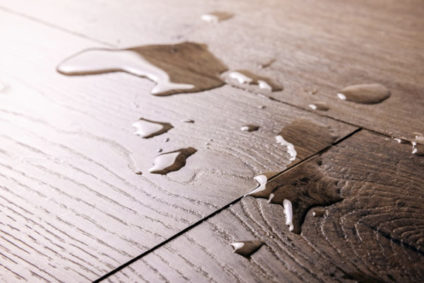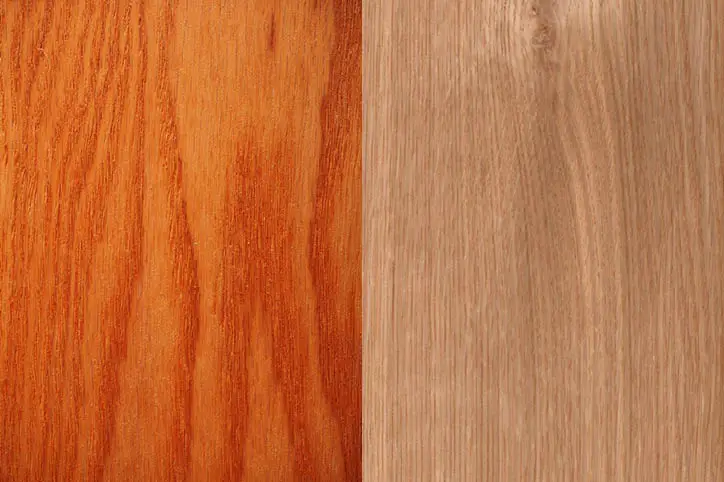Choosing the right type of hardwood flooring for your home can be a pivotal decision in achieving the desired aesthetic and functionality. Among the most popular options are red oak and white oak flooring, each offering its unique charm and set of characteristics.
Understanding the difference between red and white oak flooring is crucial for homeowners looking to make an informed choice that aligns with their decor preferences, lifestyle needs, and long-term durability expectations.
In this guide, we’ll explore the key distinctions that set these two types of oak flooring apart, enabling you to decide which one best suits your home improvement project.
The selection of wood for flooring is a decision that impacts not only the visual appeal of a space but also its practicality and resilience over time. Different types of wood come with varying grain patterns, hardness ratings, and color tones, each influencing the room’s ambiance and the flooring’s ability to withstand wear and tear.
Choosing the right wood type is thus essential for marrying aesthetics with functionality, ensuring the flooring remains a lasting element of your home’s design.
Among the plethora of options, red and white oak stand out as particularly popular choices. These species offer a compelling mix of beauty, durability, and versatility, making them suitable for a wide range of interior styles and living conditions.
Physical Appearance
Color Tones

The color tones present in red oak and white oak flooring significantly contribute to their distinctive aesthetics and appeal. Red oak boasts a warmer spectrum of colors, typically ranging from light cream to a rich reddish-brown. This spectrum allows it to imbue spaces with a cozy and welcoming atmosphere.
On the other hand, white oak possesses a cooler color palette, with hues stretching from a pale beige to a medium brown.
The more neutral tones of white oak flooring make it a versatile choice, easily adaptable to a variety of interior design styles from modern to traditional.
Grain Patterns
When evaluating the grain patterns of red oak and white oak flooring, distinct differences become apparent, influencing the overall texture and character of the space. Red oak is known for its prominent, wavy grain pattern that offers a bold and classic look, creating a sense of movement and depth.
This pronounced grain pattern can also effectively hide scratches and dents, making it a practical option for high-traffic areas.
In contrast, white oak features a tighter and straighter grain pattern, lending a smoother and more uniform appearance. The subtler grain of white oak provides a contemporary feel, suitable for minimalist and sophisticated interiors.
This difference in grain pattern not only affects the floor’s visual appeal but also its tactile qualities, contributing to the atmosphere of the room.
Hardness and Durability

Janka Hardness Rating
The Janka hardness rating serves as a critical measure for comparing the resistance of wood species to wear and denting. Red oak has a Janka rating of approximately 1290, indicating a high level of durability, though it is slightly less resistant to wear compared to white oak.
White oak, with a Janka rating of around 1360, offers superior resistance to denting and scratching. This difference, albeit marginal, reflects in the wood’s ability to withstand daily use and heavy foot traffic, making white oak slightly preferable for areas that demand higher durability.
Impact on Flooring Longevity
The Janka hardness rating directly impacts the longevity and maintenance requirements of oak flooring. While both red and white oak are considered durable choices for flooring, white oak’s higher hardness rating contributes to its enhanced longevity and lower maintenance over time.
Its superior resistance to denting and scratching means it can better maintain its appearance and integrity in high-traffic or commercial settings.
Consequently, when it comes to selecting a wood type that balances aesthetic appeal with practical durability, the slight edge in hardness makes white oak a compelling choice for those seeking flooring that combines beauty with resilience.
Moisture Resistance

Moisture Resistance Analysis
White oak’s cellular structure includes tyloses, which effectively block moisture and make it significantly more resistant to water compared to red oak. This characteristic not only enhances its durability but also its versatility in various environmental conditions.
Thanks to this natural barrier, white oak flooring is less prone to swelling, warping, or decay caused by moisture exposure.
This superior moisture resistance makes white oak an ideal choice for spaces like kitchens, bathrooms, and even outdoor settings where humidity levels can vary dramatically.
Implications for Flooring Choice
The enhanced moisture resistance of white oak has considerable implications for flooring choice across different environments.
In areas prone to high humidity or direct water contact, such as coastal regions, bathrooms, and basements, white oak flooring offers a durable solution that maintains its structural integrity and aesthetic appeal over time.
Furthermore, this resistance contributes to a lower maintenance requirement, reducing the need for frequent repairs or replacements due to water damage. Choosing white oak for flooring in moisture-variable environments can thus provide long-term benefits, combining durability with minimal upkeep.
Cost Consideration
Cost Differentiation
The cost of red and white oak flooring can differ due to various factors, including availability, grading, and the region of harvest. White oak, typically being slightly more expensive, owes its premium pricing to its enhanced durability and moisture resistance features.
Market demand also plays a crucial role, with trends and preferences occasionally leaning towards one type over the other, impacting prices accordingly.
Regional Influences
The region where the oak is harvested can markedly affect its final cost. Transportation costs, the abundance or scarcity of wood in the region, and local market demands can all influence the pricing of red and white oak.
Additionally, the cost of living and operational expenses in different areas can make the same type of wood more expensive in one region compared to another.
Finishing and Stainability
Stain Response

Both red and white oak respond differently to staining due to their distinct grain patterns and porosity. Red oak, with its more pronounced and open grain, tends to absorb stains more readily, allowing for a richer and deeper color. However, this can also result in uneven staining if not properly prepared beforehand.
White oak, on the other hand, features a tighter grain, which can make it slightly more challenging to achieve a deeply saturated color.
However, its denser structure contributes to a more uniform stain application, making it ideal for achieving consistent finishes.
Finishing Tips
Achieving the desired finish on both red and white oak requires attention to detail and preparation. For red oak, using a pre-stain conditioner helps minimize blotchiness and promotes an even uptake of stain.
Sanding the wood progressively, starting with a coarser grit and moving to a finer grit, also prepares the surface for a smoother application.
For white oak, utilizing a gel stain can enhance color uniformity due to its thicker consistency, which sits atop the wood’s surface more evenly. Additionally, both types of oak benefit from testing the stain on a scrap piece first, allowing adjustments before applying it to the entire floor.
Environmental Impact
Sourcing Sustainability
Sustainably sourcing both red and white oak is crucial to minimizing environmental impact. Red oak, being more abundant in North American forests, generally has a lower carbon footprint in terms of transportation and logging practices compared to white oak, which can be somewhat less common.
However, sustainable forestry practices, including selective logging and replanting, are essential for both types of oak. These practices ensure that the forests remain healthy and productive for future generations, maintaining biodiversity and reducing habitat destruction.
Certifications such as the Forest Stewardship Council (FSC) assure that wood is harvested in an environmentally responsible manner.
Environmental Impact
The environmental considerations in the production and disposal of oak flooring are significant. The manufacturing process, including sawing, finishing, and transportation, contributes to carbon emissions.
However, oak flooring can be environmentally friendly compared to other flooring options like carpets or vinyl, thanks to its longer lifespan and potential for recycling.
At the end of its life, oak flooring can be repurposed or biodegraded naturally, unlike synthetic materials that contribute to landfill.
To further mitigate environmental impact, consumers can opt for locally sourced oak and manufacturers who use eco-friendly finishes and adhesives.
Related Topics:
Final Recommendations
Key Differences
The primary distinction between red and white oak flooring lies in their availability, durability, and environmental impact. Red oak is more readily available and generally has a lower environmental footprint due to its abundance in North American forests.
White oak, on the other hand, offers greater durability and water resistance, making it suitable for areas prone to moisture. The choice between red and white oak should be informed by these considerations, as well as the specific aesthetic preferences of the homeowner.
Recommendations
For high-traffic areas or spaces exposed to moisture, white oak is the recommended choice due to its superior durability and water resistance. In contrast, for projects where sustainability and cost are significant concerns, red oak provides a more accessible and environmentally friendly option.
Ultimately, the best choice depends on balancing the specific needs and conditions of the installation area with aesthetic preferences. For overall versatility and environmental consciousness, red oak stands out as a commendable choice.
Conclusion
The distinction between red and white oak flooring encompasses aspects of aesthetic appeal, durability, moisture resistance, and environmental impact.
Red oak, with its warmer hues and more pronounced grain, offers a classic option that can enhance the warmth and character of a space, ideally suited for areas where cost and sustainability are primary considerations.
White oak, featuring a cooler color palette, tighter grain, and higher moisture resistance, stands as the superior option for areas requiring greater durability and water resistance.
The selection between these two types of oak flooring ultimately boils down to individual preferences, specific installation conditions, and the desired long-term outcome of the flooring project.
FAQs
Can red oak flooring be used in kitchens and bathrooms?
Yes, red oak flooring can be used in kitchens due to its durability. However, for bathrooms or other areas where the floor is likely to get wet frequently, white oak’s superior moisture resistance makes it a more suitable choice.
Are red and white oak the only types of oak flooring available?
No, red and white oak are the most common types of oak flooring, but other varieties such as European oak are also available. Each type offers unique characteristics and aesthetics.
How can I tell the difference between red and white oak flooring?
The most distinguishing characteristic is the color; red oak has a warmer tone, while white oak tends to have a cooler, more grayish hue. Additionally, white oak has a tighter grain pattern compared to the more pronounced grain of red oak.

1 thought on “Difference Between Red And White Oak Flooring”